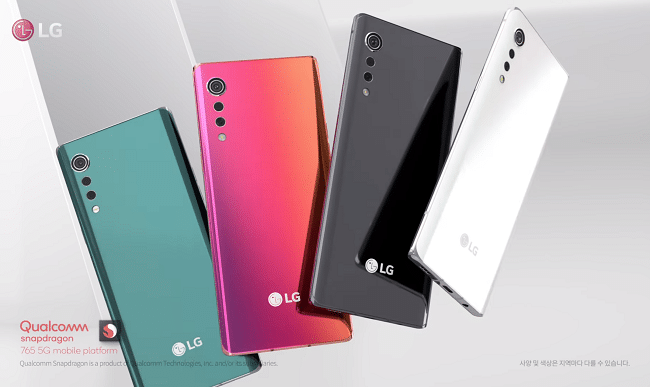
LG Velvet 5G comes to America
LG is known for its revolutionary V-series and elegant G-series lines of Android smartphones. Over time, however, there became less of a difference between the two lines. Ultimately, LG's smartphone offerings became a bit crowded and confusing. Things felt a bit... stale.
This year, however, the company decided to go in an exciting and different direction. You see, with its new LG Velvet 5G phone, the company revamped its design focus and branding. For instance, it has a beautiful "teardrop" rear camera array. Today, LG announces that the Velvet is finally coming to the USA! You won't have to wait long either, as it will become available tomorrow -- on one carrier, at least. Best of all, it is shockingly affordable for a 5G smartphone.

Protocol flaws leave 5G and other mobile networks open to vulnerabilities
Vulnerabilities affecting mobile and 5G networks are putting industrial equipment, smart homes, and city infrastructure at risk according to a new report.
Produced by Positive Technologies, this is the fourth in a series of reports on the greatest threats and vulnerabilities in the mobile ecosystem. It highlights the cyber security risks to networks that originate with the GTP protocol -- which is used to transmit user data and control traffic on 2G, 3G, and 4G networks.

IBM and Red Hat launch edge computing solutions for the 5G era
The rollout of the 5G network, bringing greater speed and lower latency to mobile data, is going to provide a boost to the utility of edge computing.
The second announcement to come from IBM's virtual Think conference today is a set of new offerings built on Red Hat OpenShift, allowing enterprises to autonomously manage workloads across a massive volume of edge devices.

Coronavirus pandemic means Apple will probably delay the next iPhone release
It's only a matter of weeks since Apple revealed the 2020 iPhone SE, but many people are holding out for this year's flagship from the company -- the iPhone 12 range, some of which will be 5G devices.
But it seems like anyone waiting to get their hands on the handset will have to wait a little longer. The chaos caused by the spread of COVID-19 around the world is said to have forced Apple to delay the launch of the phone by a month.

LG Velvet looks smooth as silk in new video
LG smartphones are often great -- not always, but usually. The company's Android devices are typically chock-full of cool features and respectable specifications. LG's V series of smartphones, in particular, have been very revolutionary. The V60 ThinQ 5G, which we reviewed recently, is one of the best Android phones in years -- as long as you also buy the useful second screen. Despite all the notable specs and features, there is a small problem with LG phones in recent years -- they look a bit dated. And yes, the design of a smartphone does matter. Look, phones aren't just handheld computers nowadays, but in addition, they are a fashion accessory and status symbol.
For LG's success in the Android market to continue, a rethink of design style was necessary. Well, the company has done just that, as it now looks to wow the world with the all-new LG Velvet Android smartphone which uses a new branding scheme. Rather than use letters and numbers to name their devices, it will use words instead -- "Velvet" instead of "V60," for instance. This is reminiscent of the automobile industry, where Ford and Chevy use bold names like "Mustang" and "Blazer" while Infinity and Volvo use cold names such as "Q50" and "XC40." The company first spoke of the upcoming device earlier this month, but now, it has released an official YouTube video as well.

Worldwide 5G connections set to reach 2.7 billion by 2025
In news that will dismay the legions of tin foil hat wearers who believe it's linked to coronavirus, data released by finance website Finbold has revealed that the number of worldwide 5G connections is projected to grow by twenty times to 2.7 billion by 2025.
The data predicts that by next year, the connections will grow by 180 percent to stand at 340 million. By 2022, the connections will be 810 million and later grow by 72.8 percent to hit 1.4 billion in 2023.

Cybersecurity 2020: The trends SMBs will need to prepare for
The rapid evolution of cybersecurity remained a major issue for small businesses in 2019, being named the top concern for all businesses, regardless of their size. Along with an increase in the number of cybercrimes, the cost of recovering from an attack means keeping ahead of the curve is vital for SMBs going forward.
This is challenging enough for businesses operating on a small budget, but fast-paced changes in technology mean that security resources are increasingly being stretched in a number of directions. Rather than protecting a single, traditional office, security must now cover a whole range of devices used for IoT and mobile working. Proactivity is now essential to an effective security strategy. By looking ahead to the trends of the next 12 months, SMBs can begin to identify the new challenges around cybersecurity that they will need to prepare for.

All 4G networks are vulnerable to cyberattack and 5G isn’t immune either
Vulnerabilites in the 'Diameter' signalling protocol used to authenticate and authorize messages and information distribution in 4G networks leave them vulnerable to attack.
Researchers at Positive Technologies replicated the actions of threat actors and their attempts to infiltrate mobile networks were 100 percent successful. They also discovered that the biggest threat was denial of service attacks.

How many Gs? Consumers confused about 3G, 5G and evolving mobile networks
Big changes are happening to mobile networks but many people remain confused or in the dark about what's going on.
A Ting Mobile survey of 1,500 customers across all US carriers finds 79 percent of people have no idea that the 3G network is being phased out across the country by 2021, nor how it will affect them.

Consumers put off smartphone upgrades because of 5G
More than half (51 percent) of global consumers have been waiting for 5G networks and smartphones to become available before upgrading their devices. This stretches to more than 70 percent of people in India and the Philippines.
A survey of over 5,000 people worldwide by Blancco Technology Group finds 45 percent of US consumers have held onto their current device for longer than usual in anticipation of 5G availability, while 61 percent intend to upgrade to a 5G device with 42 percent doing so in the next three to six months.

5G and risks to critical infrastructure [Q&A]
The speed and bandwidth of 5G means that as the roll out continues a lot of industrial automation equipment will eventually be on the 5G network.
So what can be done to protect the integrity and availability of manufacturing networks and other critical infrastructure? We spoke to Dave Weinstein, CSO of Claroty to discuss the link between 5G and the cyber security of critical infrastructure.

5G has the biggest potential to create safe cities
The latest communications industry insight report from IWCE (International Wireless Communications Expo) shows that industry insiders believe 5G has more potential than other technologies to create safe cities.
Key elements of a 'safe city' are a shared infrastructure with common sensors, multi-agency collaboration, situational awareness using real-time data, video and data analytics, and automated processes.

Google unleashes Android 11 for developers to play with
Turning it all the way up to 11, Google today launched the Developer Preview of Android 11 -- or Android R, if you prefer. For now, the preview build is only compatible with Pixel devices (no surprises there), but what can you expect to see?
Google has chosen to put privacy and security front and center in Android 11, giving users more control and transparency. The company also says that it has added things such as enhancements for foldables and 5G, call-screening APIs, new media and camera capabilities, and machine learning.

5G revenue from IoT connections to reach $8 billion by 2025
Operator-billed revenue from 5G IoT connections will reach $8 billion by the end of 2024, up from $525 million in 2020 -- growth of more than 1,400 percent in five years.
A new study from Juniper Research forecasts that 5G IoT connections will be considered as new connections that won't cannibalise existing operator connectivity revenue from current IoT technologies.

Race to 5G: The industry impact of the T-Mobile and Sprint merger
Chances are, you’ve seen the T-Mobile and Sprint merger headlines sweeping the wireless industry. The merger -- which has been caught up in court -- is the latest initiative of carriers large and small turning to corporate consolidations in order to compete in the race to 5G.
While the merger has been approved by the Federal Communications Commission (FCC) and the Justice Department (DOJ), a coalition of state officials say the merger is harmful to consumers because it significantly reduces competition within the industry and can increase prices. Despite the pushback, it appears the merger will likely follow through. So, what does this mean for the industry, the race to 5G, and -- most importantly -- wireless consumers?
